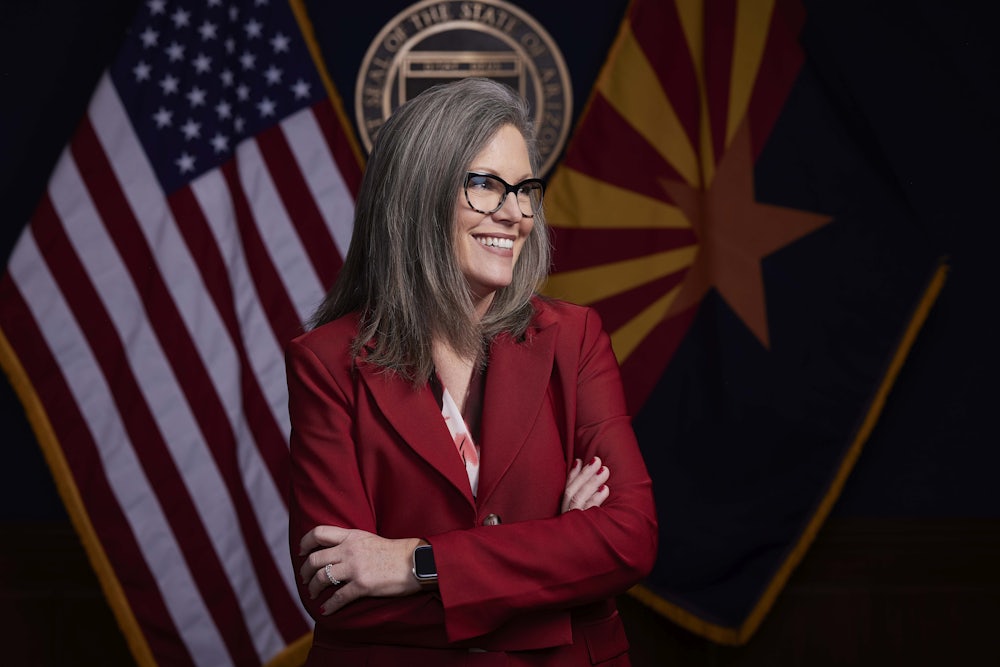The sun was still rising on a Wednesday in early January as the crowd filtered into the ballroom of a hotel in downtown Mesa, Arizona, just outside Phoenix. About 350 people, a mix of business leaders, area city and school officials, and a handful of firefighters, had come to a buffet breakfast to hear from their newly inaugurated governor, Katie Hobbs. One of three Democrats who flipped a Republican governorship in the 2022 midterms, Hobbs was spending her second week in office touring Arizona for a series of State of the State addresses. During her remarks, she highlighted several of her priorities, which mainly focused on boilerplate bipartisan appeals rather than bold declarations of a liberal shift under new Democratic governance: investments in public education, addressing rising costs, and securing water.
That measured tone wasn’t too surprising. Hobbs’s win last November cemented that Arizona is now firmly a swing state. As the state’s elections’ chief, Hobbs rose to national prominence voicing her concern about threats to democracy. Now, as governor, she helms one of the most contested and coveted states for both parties after a particularly turbulent time in Arizona history—a contentious recount battle waged by Donald Trump’s supporters in the aftermath of 2020, followed by the continued refusal of her opponent Kari Lake to concede months after the vote counts were settled.
When she was sworn in at the beginning of this year, Hobbs became the state’s first Democratic governor in 14 years. She’s also one of 12 female governors in office this year, a milestone number. “It’s really sad, actually,” Hobbs told me, “that we’re in 2023 and … only a quarter of the governors are women, and that’s a record.”
For decades, Arizona has been known as the land of Barry Goldwater, Sheriff Joe Arpaio, and SB 1070, the state’s controversial immigration law. The conservative roots run deep. While the past two elections have made it clear that the old Arizona ethos is changing, it’s still not an easy place for a Democrat. Hobbs, a self-described optimist, has said that she wants to create “an Arizona for everyone,” but she’s also a political realist who’s risen relatively quickly.
How will the new Democratic governor lead a state where the majority of constituents are barely in the middle? After all, 35 percent of Arizona’s registered voters are Republicans, and 34 percent are independents.
“We had a choice in this election, and it wasn’t about Democrats versus Republicans,” Hobbs told me later that day. “It was about sanity versus chaos. And I talked to so many people after the election who just said, ‘I voted for sanity,’ and that was like code for ‘I voted for you.’” Indeed, the election was striking, in that alongside Hobbs, Arizonans chose Democrats Adrian Fontes as secretary of state and Kris Mayes as attorney general, all in a state where fewer than a third of voters identify as Democrats. “I think we have a mandate from voters to put the partisan politics aside,” Hobbs said, “and deal with these tough issues we’re facing.”
Hobbs, 53, grew up in the Phoenix suburb of Tempe. When Hobbs was in the fifth grade, she remembered, her teacher criticized “government freeloaders.” Hobbs’s family sometimes relied on food stamps and unemployment benefits. “I didn’t really understand what she was talking about,” Hobbs recalled. Her mother was upset when Hobbs relayed the story to her. “I realized that she was talking about families like mine who needed that support to get by,” Hobbs said. She partially credits the experience for leading to her eventual career as a social worker. “Which really is why I’m here,” Hobbs said when we talked in a conference room adjoining her office at the state Capitol.
At what was then known as Seton Catholic High School in Chandler, Hobbs was on student council, the yearbook and newspaper staffs, and a member of the National Honor Society. “I’m definitely a joiner,” she told me. “I was involved in everything.” She earned degrees in social work, first a bachelor’s from Northern Arizona University and then a master’s from Arizona State University. Hobbs saw the breadth of humanity’s woes as a social worker, which eventually led her to electoral politics. “I just got very frustrated by the difficulty of making vulnerable people’s voices heard in the halls of power,” she said, “and making change that would help their lives.”
In 2010, she won a seat in the Arizona House of Representatives. Two years later, she moved up to the state Senate, and by 2015 she was already the body’s minority leader. In 2018, just eight years after her first run for office, Hobbs was elected secretary of state. Normally, that’s a sleepy backwater job, one that helps a politician move up the internal party ranks, but not one that registers on the radar of most voters. That quickly changed during the protracted election audit of the 2020 presidential race. She spoke out, calling the audit “highly partisan” and intended “to continue to tout the Big Lie.” State Senator Lela Alston, a Democrat who served alongside Hobbs in the legislature, wasn’t surprised when Hobbs stood up to election deniers, despite death threats. “I’ve seen that backbone and the grit.”
“I didn’t ever even question will I do this or not,” Hobbs told me in January, reflecting back. “It was the right thing to do.… We needed someone to stand up and defend the will of the voters, and I think it’s what I was elected to do.”
When you ask local political experts about the new governor, the words you most often hear are “moderate,” “understated,” and “civil.” In a tricky state, which until 2020 had not elected a Democrat for president since 1996, those qualities could prove useful. While there are some demographic changes driving Arizona’s recent elections —including emerging Latino voters and new transplants from blue states—the apparent swing left is more about the state’s Republican and independent voters’ distaste for the rancor and extremism of the Donald Trump MAGA era, said Samara Klar, associate professor of political science at the University of Arizona in Tucson. “We really don’t see an electorate that appears to be shifting blue,” Klar said. “Democrats in Arizona who have been successful are centrist and moderate.”
During her campaign last year, Hobbs faced widespread criticism, including from some supporters, questioning why she refused to debate Lake, an election denier and former television anchor. “It was a huge gamble,” said Richard Herrera, professor emeritus of political science at Arizona State University in Tempe. “There’s a big expectation that you stand up for yourself.” Ultimately, her decision paid off, and Hobbs narrowly beat Lake, whom Trump supported. “I don’t know how you debate someone who won’t even accept basic facts,” Hobbs told me. She calls Lake’s actions since the election, including a long-shot lawsuit that was eventually tossed out of court, “political theater.”
Unlike U.S. Senators Mark Kelly and Kyrsten Sinema, as governor, Hobbs won’t be accountable to colleagues during tough votes. Sinema, who ended 2022 by switching her party identification from being a Democrat to an independent, has faced the wrath of other senators, her party, and Arizona Democrats for not always supporting the president’s agenda. “Hobbs is free from that,” Klar said. “She is the executive of her state. She has a lot more freedom to go to the middle as much as she wants.”
Hobbs’s initial days in office mostly focused on issues without overt partisan associations: inflation, money for schools, and homelessness. Arizona’s homeless population has grown by 23 percent since 2020, among the highest increases in the nation, according to figures from the Department of Housing and Urban Development. In her first week, Hobbs issued an executive order restoring an interagency council to address homelessness and housing. Additionally, she stressed boosting funding for public education, and she plans to launch a task force to improve teacher retention. “Education gave me a chance to climb my way up and build a better life,” she told Arizona lawmakers in her first State of the State speech on January 9.
But when the speech turned to her support for reproductive rights, some GOP members in the audience revolted. A state appeals court in late December ruled that doctors cannot be prosecuted under a pre-statehood 1864 law banning nearly all abortions, but the Arizona Supreme Court could reverse that. Meanwhile, a law passed by Republicans last year banning the procedure after 15 weeks remains in effect. During her speech, Hobbs declared, “My administration will always protect reproductive freedom for all Arizonans,” which prompted a group of Republicans to walk out of the chamber.
Hobbs faces a Republican legislature with a slim majority and told lawmakers during the opening session that she wants to “work together.” But she also said “chasing conspiracy theories” or “seeking to further undermine our democracy will lead nowhere.”
Her cabinet appointments include some holdovers from her predecessor, Republican Doug Ducey. And she named a lifelong Republican, Mónica Villalobos, to co-chair her transition team. Villalobos, president and CEO of the Arizona Hispanic Chamber of Commerce, said she “really had to dig deep,” but Hobbs impressed her during a town hall. “Her style is very much a servant to the people,” Villalobos said. She was struck by Hobbs’s collaborative message to the committee: “Bring me the best and the brightest. I don’t care what party they’re from.” Hobbs was receptive to her business perspective; she “allowed me into the inner sanctum of her group and to speak honestly,” said Villalobos, who is still a Republican. “That’s brave.”




